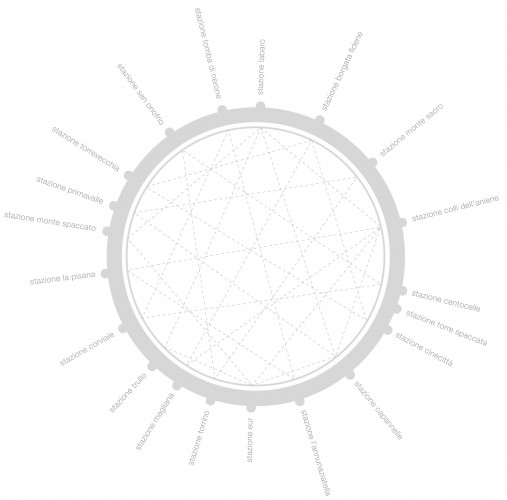
Courtesy of Weekend in a Morning Architects
Italian architects Massimiliano Marian and Andrea Cassi (Weekend in a Morning Architects), received first prize in the Rome City Vision Architecture Competition. Images and architect’s description after the break.
Rome is the city of illusions, it is not a chance
that the Church, Government, and Cinema, all things that produce illusion,
as you do and as we do, are here.
(…) which place better than this city, who died many times
and many times was reborn,
which quieter place to wait for the end by pollution, overpopulation.
The ideal place to see if the world will end or not.
(“Roma” by Federico Fellini, 1972)

Courtesy of Weekend in a Morning Architects
A cloud of aerostatic balloons is hanging over the city, airships borrowed from a time when dreaming and running after the future were compulsory. Almost a Fellinian dream, a sonnet by a famous composer played on a loose chord. Each balloon has taken off from a dock corresponding to a specific suburb, defining an imaginary circle that takes up the diameter of the Raccordo Anulare, the ring road of Rome, and embraces the city. A trampoline to look out, count the fallen and dream. Until you get back to the ground with fragments of these thoughts in your pockets.
Surrounded by the hills in a circular embrace; center of a land strip slid onto the sea, our sea. Rome is the embrace of an antique porch, open to the world. Enclosed by a ring of traffic, by mountains of houses that don’t follow the course of the river anymore; houses that all look the same, with doors and windows, piled on top of each other. Rome isn’t Rome everywhere. The circle of streets and buildings of its outskirts surround the city of souvenirs and memories: without any exchange, without any words. Like an old man and a boy, sitting on a bench with nothing to say.

Courtesy of Weekend in a Morning Architects
A vision is that place where memory and future look at each other without being afraid to speak. Sometimes a dream comes out of this. Waking up is always hard – headache and nausea. The vision that has always labeled Rome is made of the past, buildings that impose their history. Excavations for piping that take ages due to the steeplechase between buried treasures. Young american girls with sandals and international cameras as if they were in a theme park.
Waking up from a dream like this one means getting out of the historic city and moving on to what we, and not our fathers, are building. Rome isn’t Rome everywhere.
There are places where there’s no architectural or plastic element distinguishing a precise region, a particular landscape. These places reveal without any filters the inhuman nature of a maximized and globalized society, where there’s only one kind of landscape: the product of ideologies that act through simplifications or mere speculations. In these places the only thing leading back to a precise place of the territory is the skyline of the center, in a mist. The only element unifying two parallel yet divided realities is heaven. It’s the outskirts and heaven that we’re focusing on.

Courtesy of Weekend in a Morning Architects
The concept consists in creating a sort of fluctuating ring road. A new level that is added to the existing layers of the city. An immaterial level, defined only by the straight and circular trajectories of the balloons that move from one dock to the next, connecting the various Roman outskirts with each other. A system that is placed on the margins of the city that allows to seize the urban environment through new means. Knowledge, combined with the volatileness of a dreamt world, like a circus tent, like the famous travelers’ note books, these are the foundations of our views. “Let those who want to save the world if you can get to see it clear and as a whole.” (Earnest Hemingway, “Death in the afternoon”, 1932)
The outskirts turn into the center of a special infrastructural network and almost ends in themselves: the docking towers become new architectural symbols that reflect the existing physical necessity of the urban borders. At the same time they are the frame of a transport system that provides a solution for two issues: tourism and environment. Through offering the chance to fly/float over Rome, the new system is aimed at decentralizing a part of tourism, today concentrated in the old town, thus creating now opportunities for the suburbs. At the same time this new infrastructural level can be regarded as alternative to individual transport by car. A new quick and non polluting way of creating new links in urban texture. The antique taste of this airship shall remind us of evolution that has led to the creation of ever more effective and technically advanced means. We think that it’s fundamental that the poetic and fantastic aspect of this proposal is supported by a special emphasis on environmental and technical innovation issues that need to be the foundation of any urban project.

Courtesy of Weekend in a Morning Architects
A city in fact is a place where interaction takes place, where many different levels of connection exist: a real ecosystem made of continuous exchange between the substance of what’s being built and the living organisms. Infrastructures, plants and streets are the support of numerous activities, movements and both evolution and involution processes. Today it seems essential to try to understand their complexity, and that’s where new technologies can be of avail. Let’s imagine we can read parts of town with a system now present on every smartphone, that has a photographic lens: the lens of augmented reality (AR). Pictures taken from the airships are broadcast live on a screen at the bottom of each docking tower: environmental and other useful data complete the images, thus providing a genuine scan of the metropolitan situation. A new scientific medium, continuous and complete. The outskirts become the place where city is read. The grid has been completed – both physical and virtual exchange are taking place. In our vision the continuous exchange of informations between balloons and stations and stations themselves (between outskirts and outskirts, a “suburban” dialogue) guarantees transversal monitoring of the city, allowing the citizens to have better consciousness of their own role within the urban ecosystem. Hence knowledge, not only in terms of creating postcards from above or taking fascinating photographs from bird’s eye view, but rather as starting point for a necessary participation in change.
The aerostatic balloons float over the rooftops of Rome.
Try to touch the sky with your shortest fingers and look.
It’s the ideal place to see if the world will end or not.















